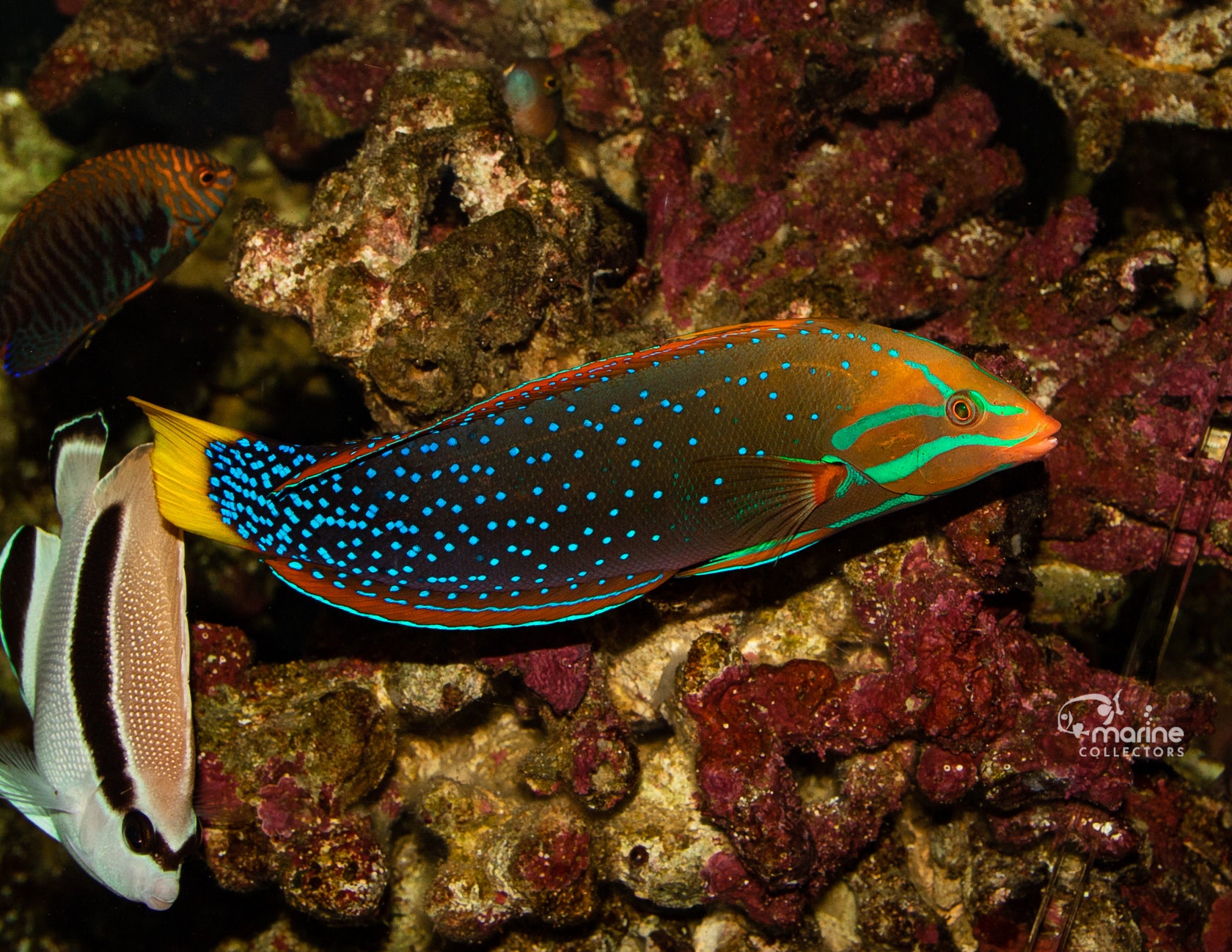Leopard wrasses, are often associated with words like “delicate”, “sensitive”, or “hard to keep.”
For the most part this is correct; in the hobby, it is very difficult to find specimens that will do well longterm. However this preconception stems from the stereotype that Leopard Wrasses don’t eat prepared foods. Why is that? For those of you who have kept a leopard wrasse long term, you know they are a relatively robust fish once they adjust and are eating. So how do we get them to this point?
To understand how to get Leopard Wrasses to do well, we first need to understand why they have such trouble. The cause is always related to handling. Wether it be the divers who actually captured the fish, how the collection station holds them, how they were packed, or how they were treated after shipping. Simply put, leopard wrasses don’t like to be touched. Now I realize that for most hobbyists, procuring a specimen that has been handled properly is next to impossible. The average person walking into an LFS will have a hard enough time tracing the history or origin of each individual fish, let alone where, who, or how the fish was treated during transit to get there.
Over the years I’ve brought hundreds of Leopard Wrasses into Marine Collectors. I’ve experimented with dozens of methods, developing a protocol that could yield spectacular results. The critical key though, for any species of leopard, is the supplier or collection station we get them from. For example, the Blue Star Leopard Wrasse (Macropharyngodon bipartitus), Marine Collectors always sources from a specific supplier in Sri Lanka, opposed to a supplier in Africa or Maldives. Source matters. Why is that, and what makes the difference?
Leopard wrasses are very sensitive to physical trauma. I personally believe almost all of the trauma is chemistry based. To get to the states, fish must be packed, and stay in small bags for extended hours. The chemistry inside a sealed bag can change drastically, and while the fish is sealed in there, they are relatively safe. Bringing them out of the bag is where all the trauma can occur. In a bag you have the water, gas (oxygen), and the organism. Lets break each one of these down.
Water: What to consider
- When packed, the water likely had relatively high pH and oxygen levels. When it arrives, the pH is likely very low and most of the oxygen has been replaced by carbon dioxide.
- Is the Salinity high or low? How much of a difference is there between that salinity in the bag and the salinity of the tank they will go in?
- Is the temp high or low?
- Is there medication (copper) in the water? If there is copper, that means no ammonia blocker or detox.
- How much ammonia is there? Enough to cause severe physical damage or a little that may cause some minor clubbing of the gill filaments?
- Oxygen (O2) - Initially, when a fish is placed in a sealed bag, the oxygen concentration within the bag is relatively high. The fish consumes oxygen through respiration and expels carbon dioxide. As time progresses, the amount of available oxygen in the bag gradually decreases as the fish continues to respirate. Lower oxygen levels can stress the fish and if oxygen depletion continues, it will cause hypoxia.
- Carbon Dioxide (CO2) - Conversely, carbon dioxide levels within the bag increase over time. Fish release carbon dioxide as a metabolic waste product. As the fish’s metabolism continues, the concentration of carbon dioxide within the bag rises, leading to a decrease in the pH of the water. A lower pH causes the water to become more acidic.
- pH changes - The pH of the water in the bag gradually decreases as a result of the rising carbon dioxide levels. As carbon dioxide dissolves in the water, it forms carbonic acid which lowers the ph. Additionally, fish secret ammonia both through waste and respiration. In an acidic environment, ammonia is less toxic. This information is crucial, when the bag is open and no longer remains sealed and the pH of the bag water wants to increase as it reacts with the surrounding air. It’s important to know that the ammonia will become exponentially more toxic as soon as this happens.
- The organism (Fish) - The fish: harmed by ammonia, rapid swings of pH, and likely hypoxic from extended periods of diminishing oxygen levels.
Ok, so how do we get the fish out of the bags in a way that allows us to slowly change the pH, match the temperature, detoxify the ammonia, and change the water?
Let’s check off the problems one at a time.
When the fish arrive, ideally direct from the source, we need to check the water chemistry. Using a syringe we can puncture the bag below the water line and suck out enough water to preform a couple tests. Salinity, pH, and copper. Checking for copper is likely the most important. Ideally all leopards should be sourced from a location where copper is not used in packing water. If there isn’t copper, we can use an ammonia blocker or Seachem Prime to treat the ammonia. If we treat the ammonia, we can let the pH change a bit without worry of harming the fish. If we can let the pH change, we can open the bags. So lets say we had all of these circumstances met. My preferred method of acclimation is an extend drip that allows the water to flow for hours. Excess water should then be allowed to drain off or dumped periodically. After a few hours we can be ensured that all of the water has been replaced by new water (new water should be clean water without medications). We now have a fish that should be relatively easy to work with and can begin the protocol for quarantine.
Quarantine:
The Protocol for Leopard Wrasses is as follows:
- Directly out of acclimation, the fish should be heavily dosed with Methylene Blue. I like to leave them in Methylene blue for 24-48 hours, with 100% water change every 12 hours (always re-dosing M.B. with each change), depending how they look. If the flight was in excess of 30 hours, I’ll leave them for longer.
- Following this expended bath in M.B., we change the water one more time so there is no M.B. and preform a formalin bath. The bath is at 1m/gal for 35 minutes (repeat every 5 days for a total of 3 baths).
- Immediately after, we move them to an non-coppered quarantine tank with nitrofurazone. The tank should have an adequate and established biofilter to keep ammonia nonexistent. The bottom of the tank should have silica sand or glass beads. Never use calcium based substrate. I can almost always get the wrasses on frozen foods within a few days, on occasion a particular specimen may need some coaxing, but by a week in, they should be eating well and have recovered from shipping. We almost NEVER have leopard wrasses not eat.
- Once they are eating, we begin copper treatment. Starting at 1.5 and moving the dosage to .1 every day for a week till we get to 2.2. After 14 days being symptom free of illness these fish should be robust additions to your display tank!
Thanks for reading everyone.
As always Happy Fish Keeping!
- Elliot Lim


